
Pyle W.Making electricity with hydrogen.1993
.pdf
Homebrew
Making
Electricity Homebrew with Hydrogen
Walt Pyle, Alan Spivak, Reynaldo
Cortez, and Jim Healy
© 1993 Walt Pyle
gas fed battery that never needs Arecharging! This article
describes a process for building a fuel cell using tools and techniques any skilled hobbyist with a wellequipped shop can duplicate. The fuel cell that we built can produce direct current electricity from stored hydrogen and oxygen. We obtained the hydrogen for this fuel cell commercially but plan to produce hydrogen and oxygen from a renewable energy system based on solar photovoltaics and water electrolyzers.
Cookbook Approach to Building a Fuel Cell
In this article we reveal the process we used to make a proton exchange membrane (PEM) fuel cell.
First, we describe what the PEM material is, and where to get it. Then we cover the steps necessary for preparing the membrane to use it in a fuel cell.
Next, we describe the catalyst and binders used on both sides of the PEM and the method of “hotpressing” them all together to form the single fuel cell catalyst-PEM-catalyst “sandwich”.
Finally, the holder for the catalyzed PEM fuel cell with its gas supply piping, insulators, and wiring studs is shown.
Some PEM fuel cell performance data were obtained using an electrical resistor to provide a variable load. Two digital multimeters and a shunt resistor were used to measure the voltage and current, so we could calculate the power produced.
Although the fuel cell described produces a relatively low voltage, several fuel cells of this kind can be wired in series to produce higher voltages and do useful work.
The PEM Material
The PEM (proton exchange membrane) material is a perfluorosulfonic acid polymer film. Several manufacturers make PEMs in one form or another. We used one made by du Pont called Nafion 117. Nafion 117 is a transparent polymer film about 175 microns (0.007 inches) thick. Dow Chemical Co., Asahi Chemical Co., and Chloride Engineers Ltd. make something similar. A patent describing how one PEM manufacturer’s film is processed is listed in the references section at the end of this article.
The basic structural unit formula for Nafion 117 is shown below:
CF2 = CFOCF2CFOCF2CF2SO3H
\CF3
Nafion 117 contains fluorine, carbon, oxygen, sulfur, and hydrogen arranged in repeating polymer molecules. The hydrogen atom on the SO3 part of the molecule can detach from one SO3 site. The free H+ proton can hop from SO3 site to SO3 site through the material, to emerge on the other side of the membrane. This is the reason it is called a proton exchange membrane. It can be thought of as solid sulfuric acid, an electrolyte.
The PEM is relatively expensive at this point in time. We paid about $100 for a 30.5 centimeter by 30.5 centimeter (12 inch by 12 inch) piece of Nafion 117 from a chemical supply house. Some manufacturers want your first born child in exchange for a sample. However, du Pont really is in the PEM business, and they will sell it to you with no strings attached from their pilot plant production. The price comes down to about $65 for the same size piece when you buy four times as much PEM direct from du Pont. The piece we bought was large enough to make about six of our round fuel cells ($10–$16/cell).
Punching the PEM Disk from a Sheet of Nafion 117
We set the sheet of Nafion 117 on a piece of clean acrylic plastic using clean cotton gloves to avoid contaminating the sheet with fingerprints. Then we punched out some round PEM disks using a 4.76 centimeter (17⁄8 inch) arch punch and a mechanics hammer filled with lead powder. After one or two tries, we found that several strikes with the hammer at different angles was best for cutting the disk free from the sheet. Striking the punch too hard shattered the acrylic sheet.
42 |
Home Power #35 • June / July 1993 |
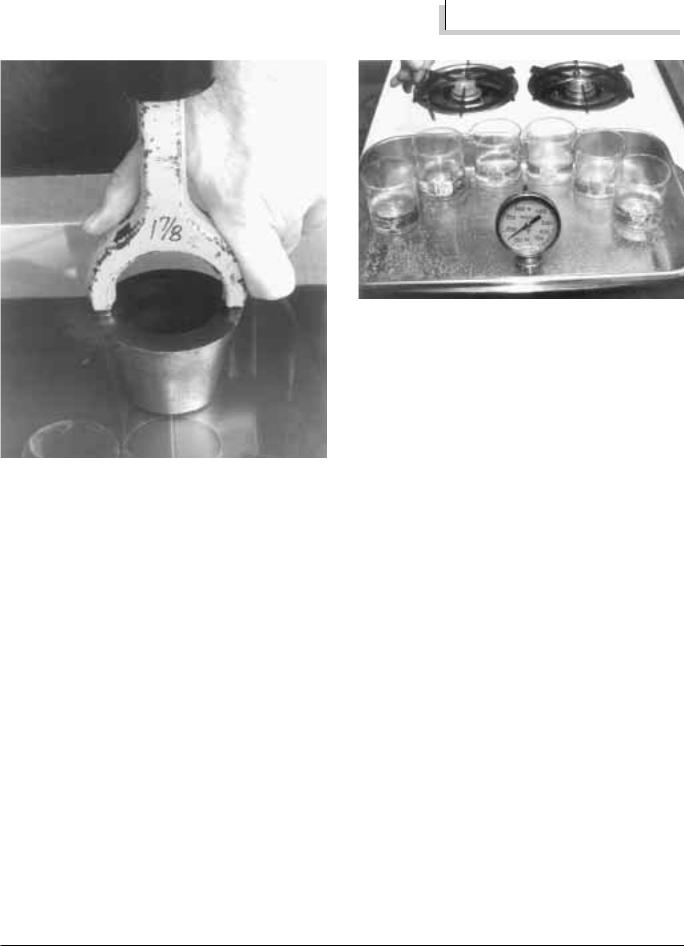
Homebrew
Above: Punching PEM from sheet with arch punch.
Photo by Reynaldo Cortez
Handle the PEM with tweezers or forceps to prevent contamination. We used a pair of stainless steel tweezers which were ground flat and polished on the grasping faces to eliminate burrs and prevent puncturing or denting the soft PEM. Grasp the PEM disks only on the outer peripheral edge, never on the inner active area.
Preparing the PEM for Catalyst Application
We prepared the film for catalyst application by dipping it in six different heated solutions in glass beakers. The solutions were all held at 80°C (176°F) by immersing the beakers in a heated pan of water on top of two gas stove burners as shown above right.
Each beaker held the PEM film for one hour in sequence. Use safety glasses and gloves while working with the solutions. The sequence of beakers used to dip the PEM was set up as follows:
Beaker 1 = 100 milliliters of distilled water [hydrate the membrane and dissolve surface contaminants].
Beaker 2 = 100 milliliters of 3% hydrogen peroxide solution (USP) [remove organic contaminants from PEM surface].
Beaker 3 = 100 milliliters of sulfuric acid (new battery electrolyte) [remove metal ion contaminants from PEM surface, and sulfonate the PEM surface].
Above: Solutions in beakers on top of stove.
Photo by Reynaldo Cortez
Beaker 4 = 100 milliliters distilled water [rinse sulfuric acid from surface and hydrate PEM].
Beaker 5 = 100 milliliters distilled water [repeat rinse].
Beaker 6 = 100 milliliters distilled water [repeat rinse].
While the PEM disk is in a beaker, there may be a tendency for the film to curl and lift on the steam bubbles, rising to the surface. It should be kept submerged so the top side doesn’t get exposed to air. Use a clean inert polyethylene plastic or glass probe to keep it down in the dipping solution.
We used a Taylor candy thermometer for controlling the beaker bath temperature, and adjusted the gas stove burner controls as needed. From time to time, more water had to be added to the bath surrounding the beakers, due to evaporation.
After the PEM disk was dipped in each of the six hot solution beakers for an hour, it was then wiped with a piece of lint-free lens cleaning tissue, and air-dried in a clean place.
The Catalyst Layer Material
The catalyst layer is the most expensive part of this fuel cell. It is made from a mixture of platinum, carbon powder, and PEM powder, bonded to a conductive carbon fiber cloth. We obtained ours from E-Tek Inc. The cost for an order of their ELAT catalyst cloth sheet includes a setup charge. So get together with others for a larger order if you want to keep costs down. We paid $360 for a piece of ELAT 15.2 centimeters by 15.2 centimeters [6 inches by 6 inches] including the $150 setup charge. This piece provides enough for about twelve disks. Each fuel cell requires two disks of ELAT and one larger disk of PEM to make the sandwich, so you can make six cells from this size
Home Power #35 • June / July 1993 |
43 |
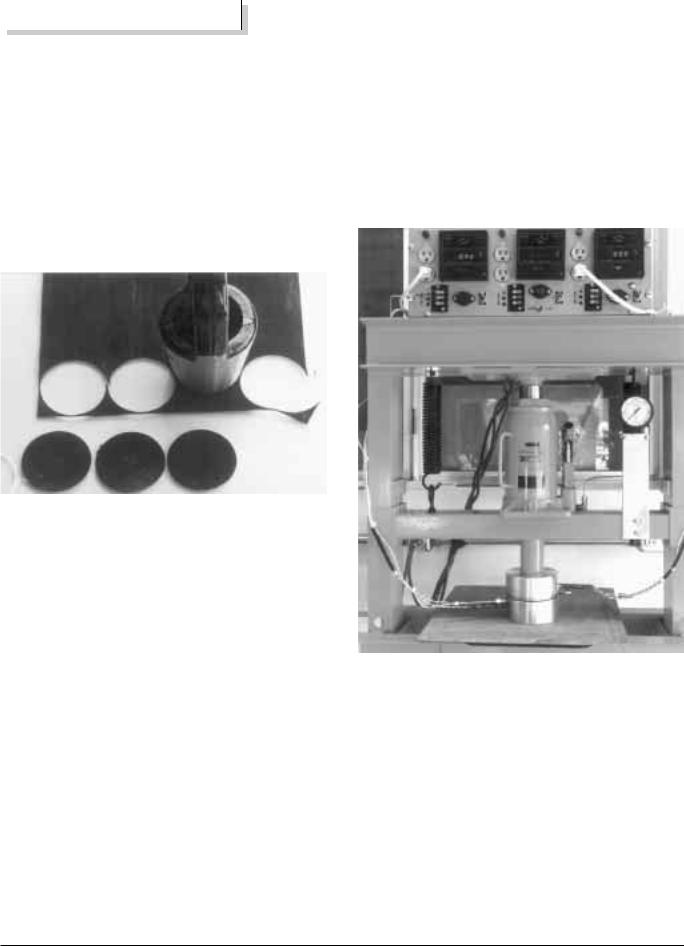
Homebrew
piece of ELAT ($60/cell). The cost may have come down by now due to increased production at E-Tek.
In the future it may be possible to reduce the cost by putting the catalyst coating directly on the PEM with a platinum-carbon ink, as practiced by Los Alamos National Laboratory.
Preparing the ELAT Catalyst/Binder Layers
Two catalyst layer disks were punched from an E-Tek ELAT sheet. The sheet was placed on clean acrylic plastic and the disks were punched with a 3.8 centimeter (1.5 inch) arch punch and the mechanics hammer.
Above: Cutting ELAT catalyst disks.
Photo by Reynaldo Cortez
Be careful to keep track of which side is the active side of the catalyst impregnated carbon cloth. The active side has more of the carbon-platinum binder powder and is smoother.
Hot-Pressing the Sandwich Together
A hot press was made using a hydraulic 20 ton shop press, and two homemade aluminum heating plates. Each heating plate was drilled to accept an electric cartridge heater and a thermocouple. A temperature controller was connected to the heater and thermocouple on each heating plate.
The bottle jack on the hydraulic press was drilled and tapped to accept a 1⁄4 inch NPT pipe to connect to a pressure gauge.
Procedure for Hot Pressing
First, two ELAT catalyst disks were coated with liquid Nafion 117. The coating only went on the active side that was to be bonded to the PEM. We used a cosmetic brush to put on a single coat (thick enough to give a wet appearance) then let it air dry at room temperature in a clean place for one hour. The liquid Nafion 117 has a strong alcohol odor, so do this coating process in a well-ventilated area.
Next, we coated the heating plates with graphite from a number two pencil and smoothed it out with a Q-tip to make a release and contamination shield layer. The three layers (catalyst-PEM-catalyst) of the sandwich were then set on top of the lower heating plate. After carefully aligning the layers, so that the smaller catalyst disks were centered above and below the larger PEM disk, the upper heating plate was placed on top of the sandwich. At this time the heaters were off and the plates were at room temperature.
Above: Hot press and heating plates.
Photo by Reynaldo Cortez
Next, the two temperature controllers were activated and the sandwich was taken up to 90°C (194°F) for one hour to evaporate the solvents from the liquid Nafion 117 catalyst coating. The temperature was then raised to 130°C (266°F) over the next 30 minutes. This is the PEM glass transition temperature.
Once the heating plates and the sandwich reached 130°C, pressure was applied using the hydraulic jack, up to 2.16 MPa (300 psig). Shortly thereafter, the pressure fell off as the PEM was squeezed by the heated plates and the sandwich became thinner.
After two minutes at temperature and pressure, the temperature controllers were turned off and the plates and sandwich cooled to room temperature.
44 |
Home Power #35 • June / July 1993 |
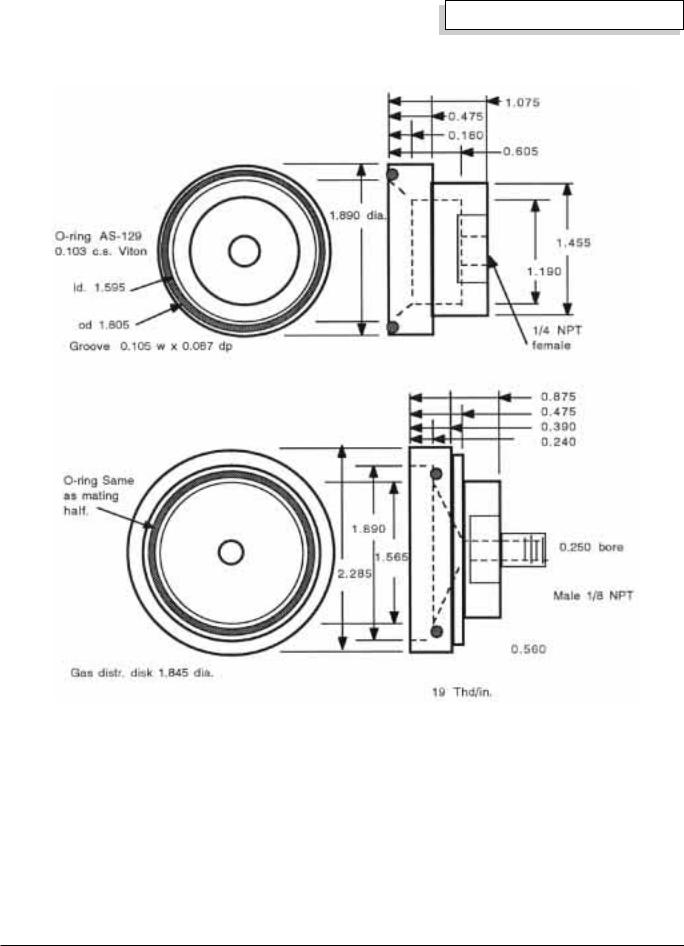
Homebrew
Fuel Cell Membrane Test Fixture
The heater plates were opened, and the finished fuel cell sandwich was removed using the special tweezers. We noted that the PEM disk was no longer round, but instead somewhat elliptical. This may be due to alignment of the film molecules in one preferential direction. The fuel cell sandwich did not stick to the aluminum heater plates, so the graphite release coating appeared to be effective.
Fuel Cell Test Fixture
Our fuel cell test fixture was made from a commercially available membrane filter holder. We spot-welded electrode studs to the two halves of the fixture case, one for the hydrogen side and one for the oxygen (air) side.
Diagram by Alan Spivak
A groove for an “O” ring was machined into each half of the case, to provide a seal to prevent the gases from leaking around the edges of the gas distribution plates.
Kapton tape was applied to the inside diameter of one case to insulate it from the other. Kapton tape was also applied to the outer diameter of the mating case to insulate the retaining ring and prevent the two cases from shorting together. An ohm-meter was used to assure that the two cases were well-insulated from one another.
The PEM sandwich was trimmed with a pair of scissors until it was round again, and placed between the filter
Home Power #35 • June / July 1993 |
45 |
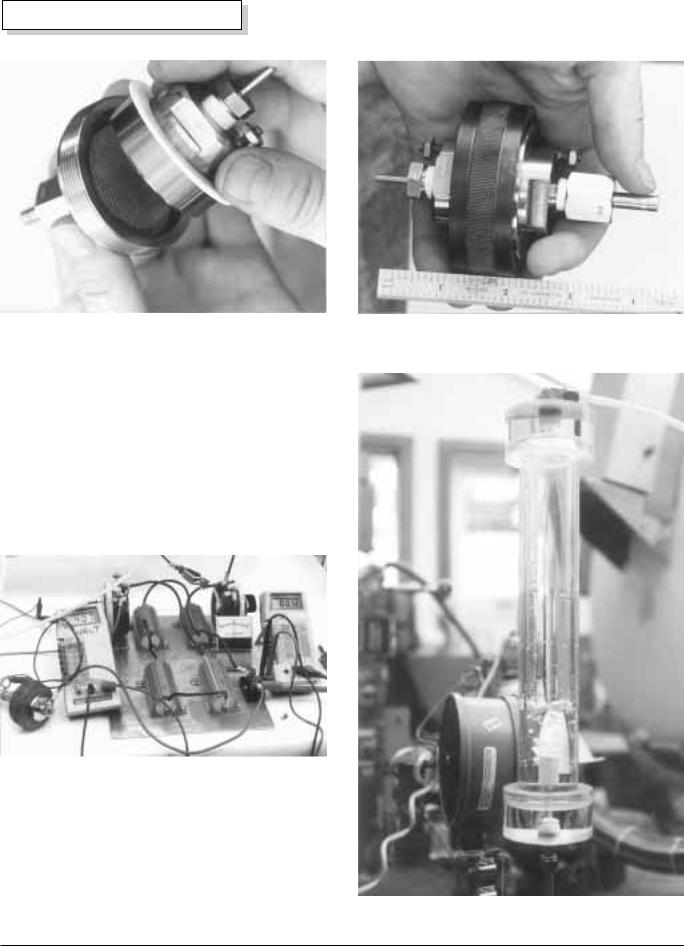
Homebrew
Above: Fuel cell disassembled, showing a gas distribution plate on the left.
holder’s two stainless steel gas distribution plates to make a five layered sandwich. The five-layered sandwich was then dropped into the Kapton lined case and the other case (with the Kapton on the outside) was applied on top and attached by the threaded retainer ring.
Fuel Cell Load Test System
An electrical testing load system was prepared as shown below using two variable resistance potentiometers rated at 0 to 1.0 ohm at 25 watts, a current measuring shunt, and two digital multimeters.
Above: Electrical test system. The four fixed resistors were not used.
Hydrogen Humidification Bubbler
A hydrogen humidification bubbler was made to prevent the fuel cell PEM from dehydrating under load. Moisture management in the PEM is an engineering challenge, due to ohmic heating when high currents flow, and osmotic drag of moisture towards the oxygen side of the sandwich. The osmotic drag is caused by the migration of protons through the PEM.
Above: Fuel cell assembled.
Photo by Reynaldo Cortez
Above: H2 humidification bubbler.
Photo by Walt Pyle
46 |
Home Power #35 • June / July 1993 |

Homebrew
We made the bubbler out of a 30.5 centimeter (12 inch) length of 5.08 centimeter (2 inch) outside diameter, 1⁄4 inch wall, acrylic tubing, and two 5.08 centimeter (2 inch) lengths of 7.6 centimeter (3 inch) diameter acrylic round bar stock. The round bar stock pieces were then machined to accept the length of tubing and glued together, using acrylic cement.
Holes were tapped in the center of each piece of bar stock to accept 1⁄4 inch NPT pipe, and a Kordon Mist Air aquarium bubbler was glued into a smaller hole on the bottom inside of the bubbler.
First Test Results
Our first test was made on our fuel cell at the Schatz Fuel Cell Laboratory at Humboldt State University during January 1993. Leak testing was done by setting the fuel cell test fixture in a container of water. We applied atmospheric air pressure and hydrogen pressure (approximately 100 KPa (14.5 psig)) and found significant leakage of hydrogen around the edges of the sandwich. The open circuit voltage of the fuel cell was almost zero, because the hydrogen was leaking into the air side. With the help of the Humboldt State wizards, however, a piece of tubing was inserted into the air fitting. Blowing air into the tubing flushed out the leaking hydrogen through the annulus and provided oxygen. This gave an open circuit voltage of 0.68 Volts, showing us that we had a functional but very leaky cell.
If At First You Don’t Succeed....
Following our visit to the Schatz Lab, we went back to the drawing board and added the “O” ring seals to the case. In March 1993, the cases were machined to accept the “O” rings and we were ready to try again. Another dip in the water container with 200 KPa (30 psig) hydrogen pressure showed that the leaks in the fuel cell test fixture had been stopped.
Another series of tests were run on our shop resistance load tester. This time, the open circuit voltage reached 0.95 Volts. Using the Humboldt tubing and annulus flushing technique on the air side, we were able to prevent the nitrogen gas from concentrating inside the cell (as the oxygen was consumed from the air). We obtained a short circuit current of over 1.5 Amperes for short periods of time (minutes). And then, by varying the load resistance we obtained data at different operating voltages and currents for the cell. Sustained power output was limited, we think, by poor moisture control on the cathode (too dry) or anode (too wet). A graph of the current-voltage response of the cell is shown above.
Future Direction
This saga has only just begun, and we are learning some valuable lessons as we go. Water management
PEM Fuel Cell Test Results
|
1.0 |
|
|
|
|
|
|
|
|
|
0.8 |
|
|
|
|
|
|
|
|
DC |
0.6 |
|
|
|
|
|
|
|
|
|
|
|
|
|
|
|
|
|
|
Volts |
0.4 |
|
|
|
|
|
|
|
|
|
|
|
|
|
|
|
|
|
|
|
0.2 |
|
|
|
|
|
|
|
|
|
0.0 |
|
|
|
|
|
|
|
|
|
0.0 |
0.2 |
0.4 |
0.6 |
0.8 |
1.0 |
1.2 |
1.4 |
1.6 |
|
|
|
|
|
Amperes |
|
|
|
|
H2 pressure = 10 psig; Air pressure = atmospheric
on both sides of the cell is a major challenge. On the hydrogen side, the PEM must be kept damp so it won’t crack, and short or leak. On the oxygen side, water is produced which must be removed so the ELAT catalyst won’t “drown” and get starved for oxygen.
We plan to try some experiments with oxygen instead of air on the anode side. Wick-like materials will be tried for passively absorbing and transporting water to the PEM and transporting water from the ELAT anode catalyst.
Ultimately, we’d like to have a 12 Volt or 24 Volt fuel cell that could be used in the home to power a 2 kW inverter for supplying 120 Volts, 50/60 Hz alternating current. Batteries would be eliminated, and solar energy would be stored as hydrogen and oxygen in tanks until it was needed. Others are dreaming of PEMFC cars, and locomotives. As we go to press, Ballard Battery Co. in Vancouver B.C. is driving a fuel cell powered bus around the parking lot!
Please let us hear from you if you have any suggestions for improvements or new experience to share. We don’t want to squirrel this technology away; we’d rather set it free!
Hydrogen Safety Considerations
For a more thorough discussion of the safety consciousness one should develop when working with hydrogen, see our article on “Heatin’ with Hydrogen” (Home Power #34). The bottom line is:
Work with hydrogen out of doors or in a wellventilated area.
Store only pure hydrogen or oxygen, never mixtures of gases.
Remember the explosive mixture limits are wide and different from other fuels: even very rich hydrogenair or hydrogen-oxygen mixtures can burn violently.
Home Power #35 • June / July 1993 |
47 |
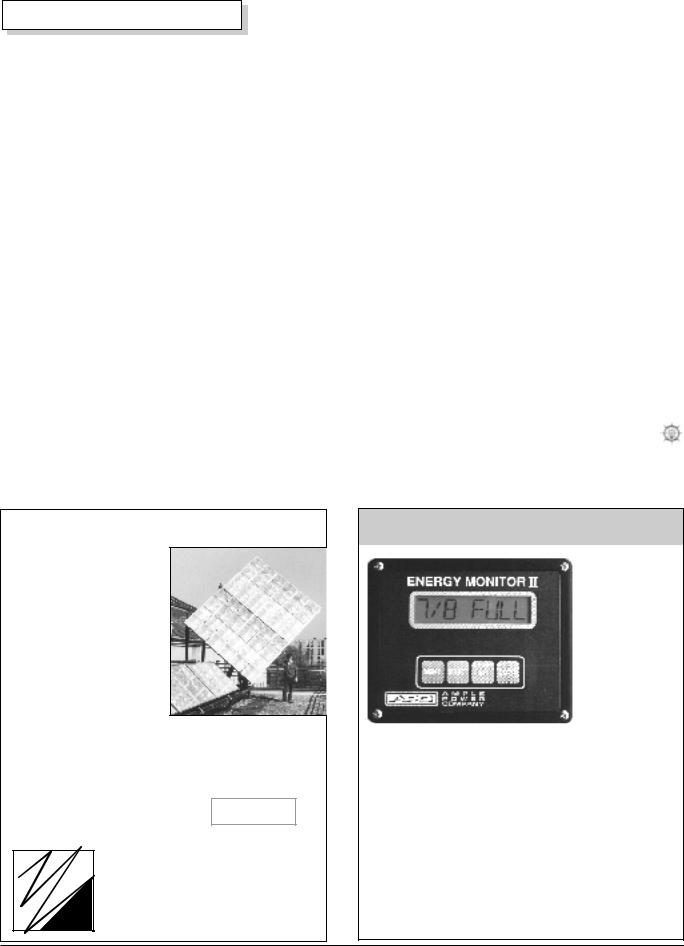
Homebrew
Access
Authors: Walt Pyle, WA6DUR, Richmond, CA • 510- 237-7877
Alan Spivak, KC6JZN, Berkeley, CA • 510-525-4082 Reynaldo Cortez, Richmond, CA • 510-237-9748 Jim Healy, WH6LZ, Richmond, CA • 510-236-6745
References
U.S. Patent No. 4,661,411, “Method For Depositing A Fluorocarbonsulfonic Acid Polymer From A Solution” April 28, 1987; Inventors: C.W. Martin, B.R. Ezzell, J.D. Weaver; Assigned to Dow Chemical Co., Midland, MI
Acknowledgements for Articles and Discussions
Supramaniam Srinivasan, A.C. Ferreira, Imran J. Kakwan, David Swan; Texas A&M University, College Station, TX
Roger Billings, Maria Sanchez; International Academy of
Science, Independence, MO
Peter Fowler, E-Tek Inc., Framingham, MA
Peter Lehman, Tom Herron, Ron Reid; CA State University at Humboldt, Schatz Fuel Cell Laboratory, Arcata, CA
David Booth, Alternative Energy Engineering, Redway, CA
PEM Materials
Nafion 117 PEM (du Pont) 0.007 inch thickness: Aldrich Chemical Co., Catalog No 29,256-7
Nafion 117 solution (Nafion perfluorinated ion-exchange powder 5% mixture of lower aliphatic alcohols and 10% water d 0.874): Aldrich Chemical Co., Catalog No. 27,470-4 • 800-558-9160
Nafion 117 PEM (orders greater than 0.61 m by 0.61 m [24 inches by 24 inches] or larger): I.E. du Pont de Nemours & Co., Customer Service Dept. • 302-695-5249
Catalyst/Binder Materials
ELAT Solid Polymer Electrolyte Electrode 20% Pt/C with 0.4 mg/cm2 Pt loading: E-Tek, Inc., 1 Mountain Rd, Framingham Industrial Park, Framingham, MA 01701 • 508-879-0733
Test Fixture
Stainless Steel In-line Filter Holder: Catalog No. L-02929-20 (47 mm), Cole-Parmer Instrument Co., 7425 N. Oak Park Ave., Chicago, IL 60648 • 800-323-4340
Hot Press Components
20 Ton Hydraulic Press: Post Tool Co. 800 E. 8th Street Oakland, CA • 510-272-0331
Temperature Controllers, Thermocouples, Cartridge Heaters
Omega Engineering Inc., 1 Omega Dr., Stamford CT 069070047 • 203-359-1660
THE POWER SOURCE™ |
Amp-Hours Simplified! |
|||
• Two-stage optical |
|
Messages |
||
concentration — Over |
|
|||
ONE HUNDRED AND |
|
like |
||
FIFTY SUNS! |
|
|
||
• Electrically tracks the |
|
7/8 FULL, |
||
sun to within 1° without |
|
|||
|
|
|||
any adjustment-year in |
|
make |
||
and year out. |
|
|
everyone |
|
• Internal battery pack |
|
|||
automatically |
|
|
a battery |
|
repositions the array to |
|
|||
the East after sundown! |
|
expert! |
||
• Withstands over 100 mph windloading. |
||||
|
||||
• 4 Module 260 Watt array |
|
With programmable alarms, a generator start/stop |
||
• 8 Module 520 Watt array |
|
|||
|
output and optional computer software to display |
|||
• 12 Module 780 Watt array (pictured) |
||||
and log data, why not take a few minutes and install |
||||
• Includes the Tracker! |
|
|||
Serious Dealer |
the economical, 12/24 Volt Energy Monitor II. For a |
|||
• TEN year warranty |
||||
Inquiries Invited |
fully integrated system, connect the Energy Monitor |
|||
• Made in the USA. |
|
|||
|
|
II to the Smart Solar Regulator or the Smart Multi- |
||
|
Midway Labs Inc. |
|||
|
Source Regulator for both solar and wind regulation. |
|||
|
2255-HP East 75th Street |
Ample Power Company |
||
|
Chicago, IL 60649 USA |
|||
|
1150 NW 52nd St., Seattle, WA 98107 |
|||
|
312-933-2027 |
|||
|
(206) 789-5758 or 1-800-541-7789 |
|||
|
FAX 312-933-2039 |
|||
48 |
Home Power #35 • June / July 1993 |
|
||
